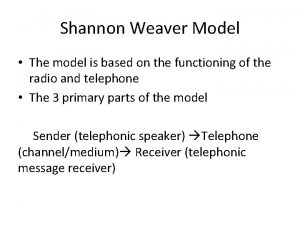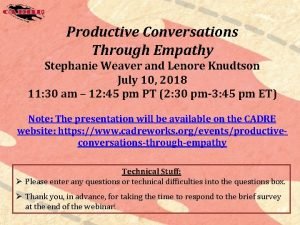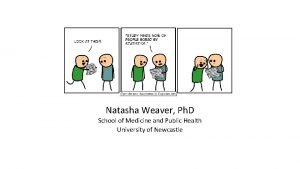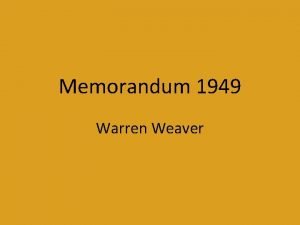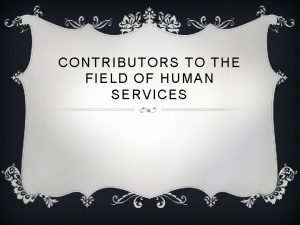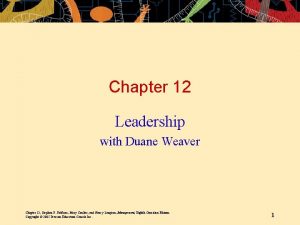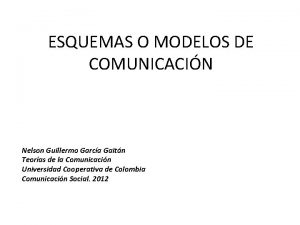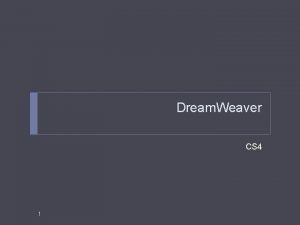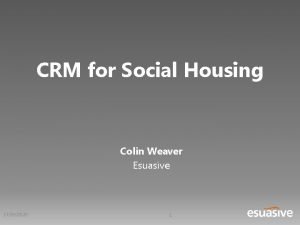MAKEDA WEAVER PROJECT WHAT IS MAKEDA WEAVER Makeda



















- Slides: 19

MAKEDA WEAVER PROJECT

WHAT IS MAKEDA WEAVER

Makeda Weaver works together with local authorities, metropolitan police and other agencies to help individuals extricate themselves from the gang lifestyle The Project achieves this by offering intensive supportive services, mentoring, education, employment, and job training

WHO IS RAGS FOR?

RAGS TARGETS SECOND-TIER GANG MEMBERS

Traditionally, when police operations take out high-level targets. . .

. . . those lower in the hierarchy quickly move into new positions within the gang structure to fill the power vacuum.

We aim to intervene in this rapid re-growth of the gang structure by building off the momentum of high-profile arrests and targeting those individuals who exist within the gang’s middle tiers or else have been identified as being amenable to a change in lifestyle choices

ADDITIONALLY. . . • We aim to work with anyone threatened or intimidated by gang peer groups • Either those whose criminality is primarily perpetuated by their peer group associations – or those whose safety is at risk • We aim to work with young people in custody with prior gang ties who will be returning to the community and might want to exit the gang lifestyle.

HOW DOES THE PROJECT WORK?

WHAT ARE SOME OF THE PRIMARY REASONS FOR GANG AFFILIATION? Environmental Peer Group Pressure Exposure to Lifestyle Poverty Dysfunctional Family Individual Lack of Confidence Lack of Education & Opportunity Lack of Role Models

MW SEEKS TO MITIGATE SOME OF THE PRIMARY CAUSES OF GANG PARTICIPATION BY ADDRESSING ITS ROOT CAUSES: • Replacing peer group pressure with positive peer role models • Mitigating the exposure to the gang lifestyle by a change in environment • Working in cooperation with family and significant others to improve personal relationships and support networks which can encourage prosocial behaviours • Helping to improve client confidence through intensive program offerings • Offering education, job training, and employment opportunities • Providing older inspirational role models.

MW CORE Attitude Mentoring & Positive Role Models Change in Environme nt Offende r

MAKEDA WEAVER The reasons for the change • It addresses the core issues of peer group, environment, and attitude – issues which need to be addressed for any long-term prosocial behavioural adjustments to be made before clients are likely to be successful in traditional goals such as education and employment. • It provides resettlement workers with time to research and develop quality intervention plans for the client.

Change in Environment Traditionally, offender supervision programs that attempt to work with offenders have mixed success because. . . • The client returns to the same environment that has caused his anti-social behaviour, making it difficult for behavioural changes to occur. MW aims to correct these mistakes by. . . • Contractually requiring that the client abstain from prior peer group associations and geographic areas. • Sometimes, depending on circumstances, re-housing the client into a new environment where his transition will be monitored and supported. (This can be somewhere else within the borough or outside of borough depending on circumstances. ) • Creating an environmental change through positive role modelling and engagement with constructive activities and programs.

Attitude Traditionally, offender supervision programs that attempt to offer offenders education and employment opportunities have mixed success because. . . • The primary facet of the education or employment opportunity is offered before underlying attitudinal changes have occurred. MW aims to correct these mistakes by. . . • First addressing attitudes and self-confidence through an intensive gang intervention program. • By reinforcing these attitude adjustments through an intensive peer mentoring program which is reaffirmed by resettlement officer and police contact.

Mentoring & Positive Role Models Traditionally, offender supervision programs that attempt to offer offenders positive role models are unsuccessful because. . . • Too often the supervising officer, is someone not of the same ethnicity, lifestyle, or economic background of the client. • Too often the turnaround time between client expectation and mentor contact is too lengthy. • Typically, peer mentors meet sparingly with the client, offering a minimal counter-message to the primary peer group messaging. MW Project aims to correct these mistakes by. . . • Offering a variety of mentors and role models. • Establishing strategic service partnerships that provide for an immediate response for mentors to engage with clients. • By maintaining an intensive pace and frequency of messaging.

By itself, no single component of an offender’s lifestyle leads to anti-social behaviour. Rather, it’s how these lifestyle choices and circumstances work in tandem with one another. Environment conducive to antisocial behaviour Negative Peer Group Client Lack of Opportunity Too much idle time

Similarly, positive lifestyle choices and circumstances can work in tandem with one another to have a multiplying effect. Intensive Positive Peer Group New Environment Client Repeated exposure to new interests, programs, and opportunities. Busy and productive schedule
 Storybook weaver deluxe
Storybook weaver deluxe Shanon weaver model of communication
Shanon weaver model of communication Securityweaver
Securityweaver Stephanie weaver md
Stephanie weaver md Modelo shannon e weaver
Modelo shannon e weaver Natasha weaver
Natasha weaver David berlo model
David berlo model Model komunikasi shannon dan weaver
Model komunikasi shannon dan weaver Weaver memorandum
Weaver memorandum Dr terry weaver
Dr terry weaver Which human services leader linked chemistry to nutrition
Which human services leader linked chemistry to nutrition Modelo de shannon y weaver.
Modelo de shannon y weaver. Anna y reed and eli weaver
Anna y reed and eli weaver What leadership traits did weaver exhibit
What leadership traits did weaver exhibit Modelo de shannon y weaver
Modelo de shannon y weaver Modelo de comunicacion maletzke
Modelo de comunicacion maletzke Martin and hannah weaver
Martin and hannah weaver Duane weaver
Duane weaver Ifrs 102
Ifrs 102 Site:slidetodoc.com
Site:slidetodoc.com

